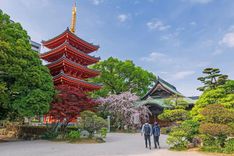- City Break
- Authentic Experiences
- Japan
- Yokohama
- See & Do
- Inspiration
Once the historical gateway to Japan, Yokohama has grown into a vibrant, multicultural city with plenty to explore. From waterfront attractions and quirky museums to world-class ramen and lively Chinatown, here are some of the top things to do in Yokohama.

Minato Mirai 21 district in Yokohama, Japan © vayata/Shutterstock
What to do in Yokohama?
The opening of an international port in Yokohama in 1859 transformed a sleepy fishing village into Japan’s second-largest city. Unsurprisingly, many of the city's top sights still cluster around the waterfront, where history, culture, and modern design collide. Exploring this area is one of the most rewarding things to do in Yokohama.
Skyscrapers and coasters at Minato Mirai 21
What were once disused dockyards have become Minato Mirai 21, a sleek central business district and a major hub for sightseeing. Head up to the 69th floor of the Landmark Tower, still one of the tallest buildings in Japan, for sweeping views that stretch across Tokyo Bay— and on clear days, all the way to Mount Fuji.
Just across the water lies Shinko Island, a man-made patch of land that’s home to Cosmoworld, a compact amusement park best known for Cosmo Clock 21, its massive Ferris wheel that also functions as a clock. It lights up beautifully at night and is a favorite for skyline selfies.
Museums worth your time
Two museums in the area make for surprisingly engaging stops. The Yokohama Port Museum dives into the city's maritime legacy and includes access to the historic sailing ship Nippon Maru, moored right beside it.
Then there’s the wonderfully quirky CUPNOODLES Museum, where you can learn about the invention of instant noodles and even create your own custom cup. It’s playful, hands-on, and a hit with kids and adults alike — perfect if you’re exploring Japan with kids and looking for something both fun and memorable.
Yokohama Chinatown: A cultural feast
As the city that reopened Japan to the world, it’s no surprise that Yokohama is home to one of Asia’s largest Chinatowns. This vibrant neighborhood is full of colorful gates, busy storefronts, and temples draped in incense smoke. Snack your way through the narrow streets — steamed buns, dumplings, and bubble tea are just the start.
A Taste of Old Japan at Sankei-en
For a breath of tradition, head about 30 minutes from Yokohama Station to Sankei-en Garden. This peaceful retreat features historic buildings relocated from across Japan, including pagodas, tea houses, and merchant homes. It’s especially beautiful in autumn, when the trees turn brilliant shades of red and gold.

The great bronze Buddha statue in Kamakura © Mumemories/Shutterstock
What is there to see outside the city?
Kamakura, 25 minutes on the train south of Yokohama, was the birthplace of the country’s first samurai government. It’s home to such an array of Zen temples and shrines that it’s sometimes referred to as the Kyoto of Eastern Japan, though the town’s most startling sight is the Daibutsu, a huge bronze seated Buddha that’s over 750 years old.
A 15-minute ride on the Shinkansen west of Yokohama, Odawara Station marks the jumping-off point for Hakone, one of the most famous hot spring resorts in Japan. Relaxing in a steaming onsen is a quintessentially Japanese experience, and there are few places that do it as well as the Prince Hakone Lake Ashinoko; work your way through the indoor hot and cold baths before heading outside for an open-air dip just yards from the lakeshore.

The Torii on Ashinoko Lake, one of the most iconic sights in Japan © THONGCHAI.S/Shutterstock

Tonkotsu ramen, one of the many varieties on offer at Yokohama's Ramen Museum © Bonchan/Shutterstock
What should I eat?
The Shin-Yokohama Ramen Museum (no, not the same as the Cup Noodle Museum) is a museum-cum-elaborate food court, set up in the style of a 1950s Tokyo street, that celebrates this incredibly popular noodle dish. There are a few exhibits that chart the history of ramen (originally an import from China), but you’re really here to try one of their regional varieties, ranging from tonkotsu (pork) from Kyushu to kelp-based ramen from Hokkaido.
Chinatown is packed with great places to eat, but it’s difficult to beat Edosei, whose huge steamed buns draw long lines of hungry shoppers. Try the black bean and walnut filling, or shrimp and chilli, or stick to the classic barbecue pork, all served in a soft, slightly sweet, sticky white bun.
The JNTO is the official tourism organisation of Japan. For more information on visiting Yokohama, see the Yokohama Convention & Visitors’ Bureau website.












